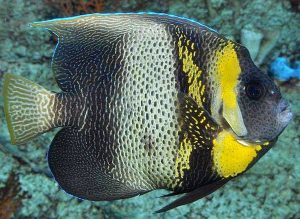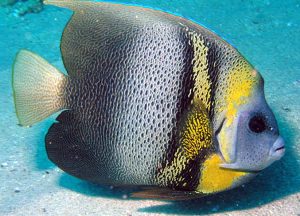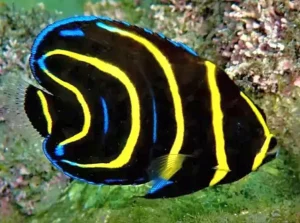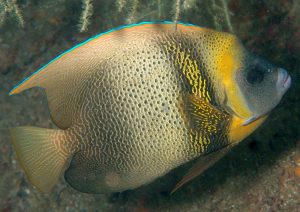Cortez Angelfish (Pomacanthus zonipectus) are widely distributed in the Eastern Pacific from Puerto Peñasco, in the northern Gulf of California of Mexico south to Peru, and Mexico, the Sea of Cortez. As a vagrant from southern California; it has also been recorded in the Galapagos Islands, Cocos Island, and Malpelo Island.
Cortez Angelfish are found at depths between 20 to over 165 feet where they appear swimming mostly in pairs or grazing on algae, sponges, tunicates, bryozoans, hydroids, and fish eggs taken from the substrate. They are active during daylight hours (diurnal), but like many reef dwellers seek shelter in crevices where they reside during the night.
The solitary and highly territorial juvenile Pomacanthus zonipectus are often found in tidal pools after the midsummer spawn, from August through November.
Adult Cortez Angelfish have a generally gray brown body color. The rear half of the body is covered with a matrix of crisscrossing lines that become yellowish green in the tail. There is a pale gray section in the middle of the flanks with a large yellow arc to the rear of the pectoral fins, and a bright yellow saddle across the nape of the fish. Although the muted brown gray coloration is not as spectacular as other members of their genus, they are a hardy graceful fish that stand out in larger aquariums.
Juvenile Cortez Angelfish have dark black bodies with six vivid yellow bands running vertically from the
mouth down to the base of the caudal fin. The dorsal and pelvic fins are accented with bright blue margins and in between and parallel to the yellow bands are electric blue bars.
Because of their beautiful juvenile coloration, Cortez Angelfish are highly sought after by tropical fish keeping enthusiasts.
Due to their large adult size, aggressiveness, and the fact that they are not reef safe; juvenile Cortez Angelfish (Pomacanthus zonipectus) are best housed in a large fish only live rock (FOLR) aquarium of at least 150 gallon capacity, with copious amounts of aged live rock for grazing and arranged into numerous hiding places. Adults require a tank of at least 500 gallon capacity and preferably larger if you house them with other large species. Keeping them with other angelfish or species that look like angelfish is not recommended.
Although some tropical fish keeping enthusiasts have managed to successfully keep Cortez Angelfish with Cladiella spp., Lamnalia spp., Litophyton spp., Sinularia spp. and other sturdy corals that produce a noxious chemical defense, reef tanks are definitely not recommended. Even in a large reef aquarium, they will pick and nip at both hard and soft corals, as well as clam mantles.
The Cortez Angelfish expels a good amount of waste which impacts the aquarium’s filtration system. Their aquarium should have strong mechanical, biological, and chemical filtration, strong water currents, and plenty of dissolved oxygen in the water.
A quality protein skimmer, wet/dry filtration system, and additional power heads
for current movement is highly recommended along with regular bi monthly partial water changes.
Cortez Angelfish appear to be monogamous and have not yet been bred in captivity. In their natural habitat, spawning takes place at sunset from midsummer to early autumn.
Cortez angelfish pairs have been observed spawning in a similar manner to King Angelfish. At dusk, males will congregate along the sandy bottom to wait for the arrival of the females. Each male will swim toward and above their female and flutter their bodies in short jittery motions until the female is ready to spawn. When ready, the female rise with the male moving below her belly to nuzzle it with his nose. As the pair quiver and swim in spirals toward the surface, they release their gametes in unison.
During a spawning cycle a single pair can produce millions of fertilized eggs. The planktonic eggs drift with the current in the water column and hatch around 20 hours after spawning. After hatching, the finless fry live off their yolk sack until it is completely absorbed, at which point they drift down to the bottom of the reef and begin to eat small zooplankton.
In their natural habitat, Cortez angelfish feed items taken from the substrate; primarily sponges, tunicates, algae, bryozoans, hydroids and the eggs of fish. In an aquarium environment they need in addition to plenty of aged live rock with for grazing; a balanced diet of Spiurlina, marine algae, a quality frozen marine angelfish preparation with sponges, and meaty items like shrimp, clams, Krill
, etc. They do best when fed small portions at least three times daily.
Cortez Angelfish (Pomacanthus zonipectus) are popular with tropical fish keeping enthusiasts but because of their specialized diet and large size are not common in the aquarium hobby. They can be ordered online from a variety of sources at the following approximate purchase sizes: Tiny: Up to 2″, Small: Over 2-2.5″, Small / Medium: Over 2.5-3.5″, Medium: Over 3.5-4.5″, Medium / Large: Over 4.5-5.5″, Large: Over 5.5-6.5″, Extra Large: Over 6.5-7.5″, Extra Extra Large: Over 7.5-8.5″, Show Size: Over 8.5-10.5″, Jumbo: Over 10.5″
Prices range from $120.00 to over $400.00 depending on size.
Minimum Tank Size: 150 gallons
Aquarium Type: FOLR – Mature live rock
Care Level: Moderate
Temperament: Semi-Aggressive
Aquarium Hardiness: Hardy
Water Conditions: 74 °F – 82 °F, dKH 8 to 12, pH 8.0 – 8.5, sg 1.020-1.027
Max. Size: 18″
Color Form: Blue, Yellow, Black
Diet: Omnivore
Compatibility: Not reef safe
Origin: Eastern Pacific, Mexico
Family: Pomacanthidae
Lifespan: 15-20 years
Experience Level: Intermediate






One Response to “Cortez Angelfish (Pomacanthus zonipectus)”
Trackbacks/Pingbacks
[…] Angelfish pairs have been observed spawning in a similar manner to Cortez Angelfish. The spawning process begins around sunset with males congregating along the sandy bottom waiting […]